Scuba Gas Planning: Gas Management For Divers
Scuba gas planning is a neglected fundamental competency in mainstream recreational diving training. It is simply the ability to accurately calculate your gas consumption and use that information to determine the limits of your dive compared to the gas supply you will carry when diving.
As a scuba diver, you should know how long you can stay at a planned diving depth; allocating sufficient gas for your ascent which includes a calculated gas reserve to mitigate against foreseeable emergency scenarios; such as air-sharing with a dive buddy.
Why is scuba gas planning important for divers?
Accurate scuba gas planning empowers the diver to set realistic limits on their dives, helps to prevent avoidable gas depletion emergencies, and ensures the diver will never be blind-sided if a regulator failure gas-loss emergency occurs.
Over time, the process of diligently gas planning your dives will contribute to developing an intuitive subconscious awareness of both your own and your team’s, real-time gas situation.
You will develop an ability to predict, with accuracy and without looking at gauges, what everyone’s gas levels are at any given point in a dive.
Furthermore, you will be able to instinctively predict how varying gas consumption will impact the dive plan – allowing dynamic and proactive adjustments to the dive plan if or when they become necessary.
Gas Management For Scuba Divers

The comprehensive, illustrated, metric guide to advanced gas planning and management for safer scuba diving. Only $9!
60 Pages. Printable PDF format. Fully Illustrated.
Gas Planning in Metric versus Imperial
The mathematics involved in gas planning is considerably simpler if using the metric system; which is why some experienced American divers convert to using the metric system for diving. Even if it is what a diver is most comfortable with, the imperial system is a little harder to use for most people because the calculations are not small round numbers.
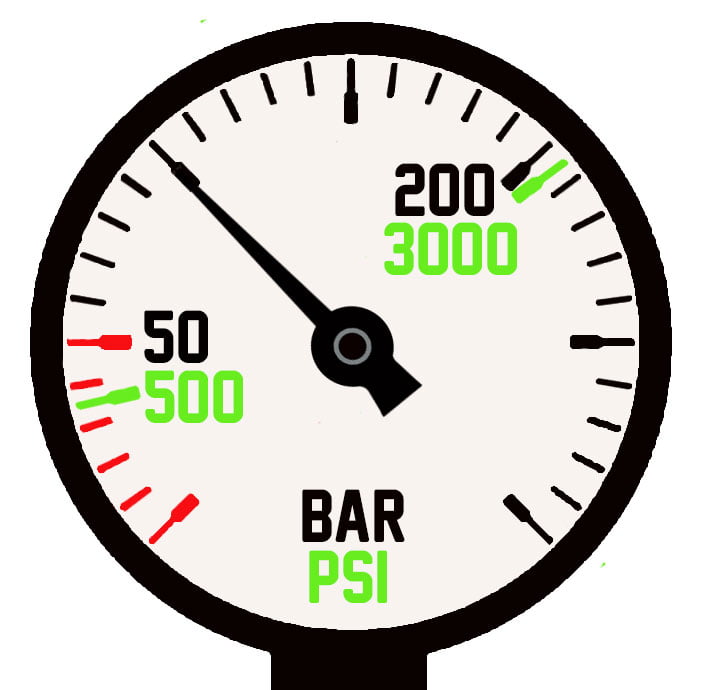
Converting to the metric system is worth the effort because all subsequent calculations become very easy. That’s especially important for scenarios where you have to calculate mentally and don’t have a digital calculator or mobile phone on hand; such as on a dive boat or when trying to problem-solve under stress when underwater.
Variation in Air Consumption
It is important to be aware that calculating your air consumption based on normal activity levels may not produce a result that reflects your respiratory rate during an emergency. Air consumption under high physical or psychological stress may be up to 10x that of normal or resting consumption.
Consequently, prudent divers should establish an understanding of both their normal and elevated air consumption rates.
Elevated air consumption is calculated in the same way as normal air consumption, except the diver should physically stress themselves with cardiovascular demand at the time they observe and record their air consumption: this typically means a short period of intense finning.
Gas Supply Calculation
The first thing to understand is the volume of gas that you will carry on the dive. Once the gas volume is calculated, a diver can calculate their air consumption and also plan their predicted gas consumption at depth versus how much gas they have available.
Cylinder capacity
The metric system makes visualizing cylinder capacity very intuitive because it is not dependent on the gas pressure inside the cylinder.
The capacity of a cylinder is simply the amount of space within it. You can visualize that for diving by imagining how many liters of water it would take to fill the cylinder.
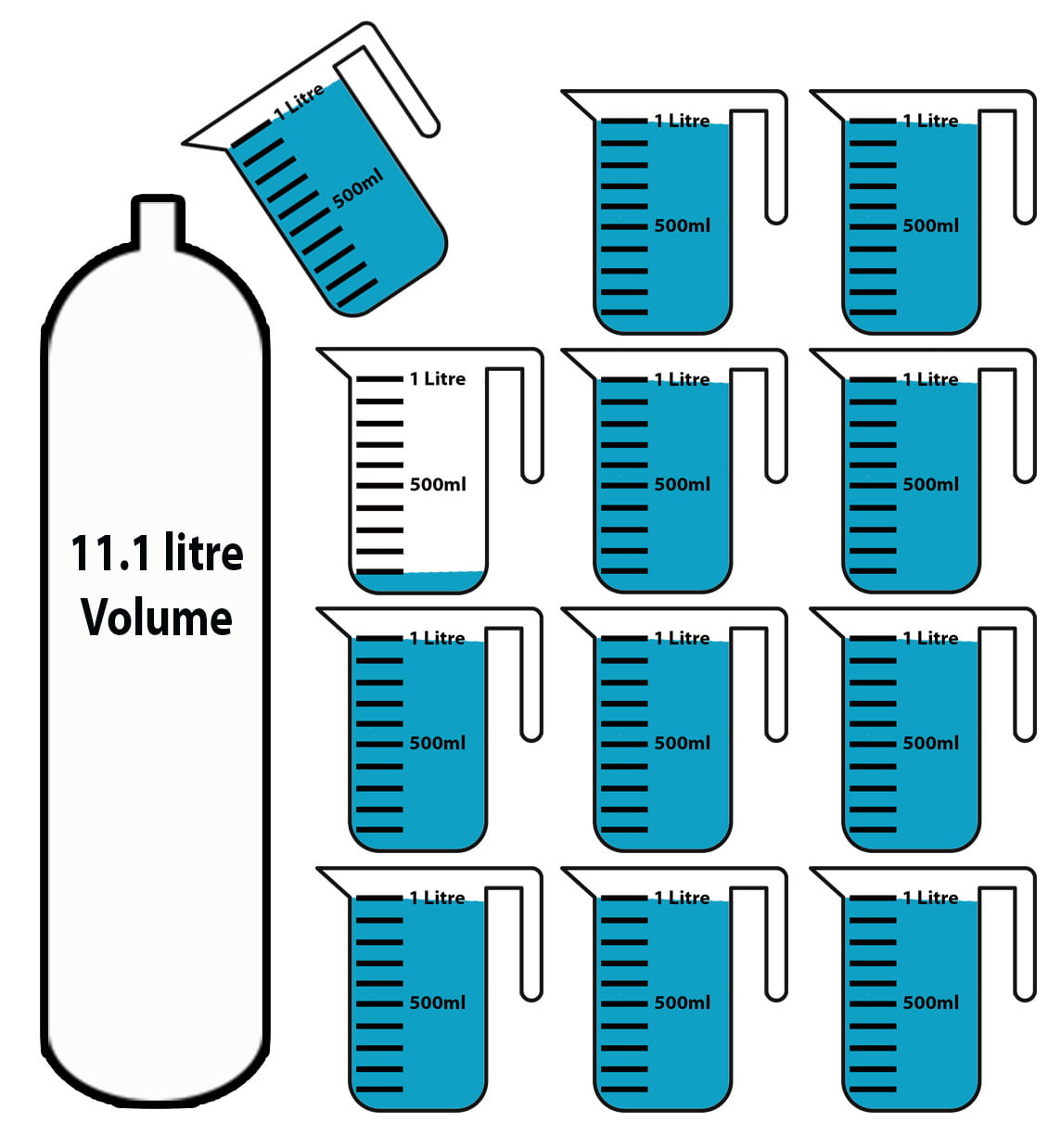
European-made cylinders usually have markings to indicate that capacity in liters, but American-made cylinders do not. Rather than attempt a mathematical conversion between imperial and metric, it is easier to just consult the manufacturers’ cylinder specifications online; they are usually also given in metric.
Calculating cylinder gas volume
As an example, let’s calculate the gas volume capacity in the ubiquitous AL80 (aluminum 80 cu ft) cylinder:
An AL80 has a metric volume of approximately 11.1 liters. It will typically be filled at 200 bar (3000psi) of pressure; meaning that there is two hundred times the volume of air compressed into the cylinder.
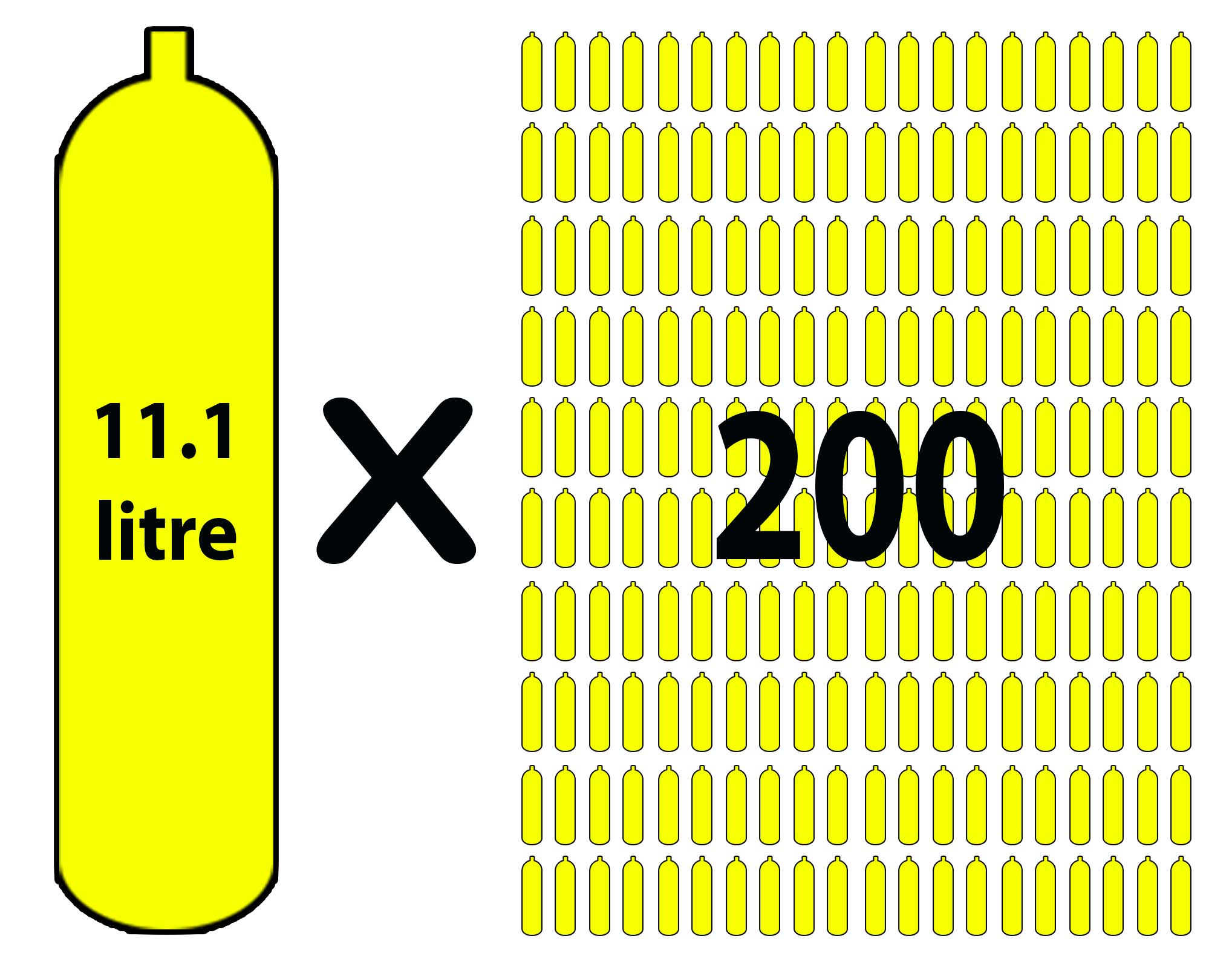
Cylinder volume capacity calculation
To calculate a cylinder gas volume, use the following metric formulae:
Cylinder Capacity x Fill Pressure = Total Gas
For example:
Cylinder Capacity (11.1 litres) x Fill Pressure (200 bar)= Total Gas (2200 liters)
Understanding Depth and Pressure
Using the metric system makes grasping the relationship between depth and pressure very straightforward. Every 10m of depth is a 1 atmosphere (absolute) of pressure (data) in salt water. For freshwater, 1 ata is every 10.3m of depth, because fresh water weighs slightly less.
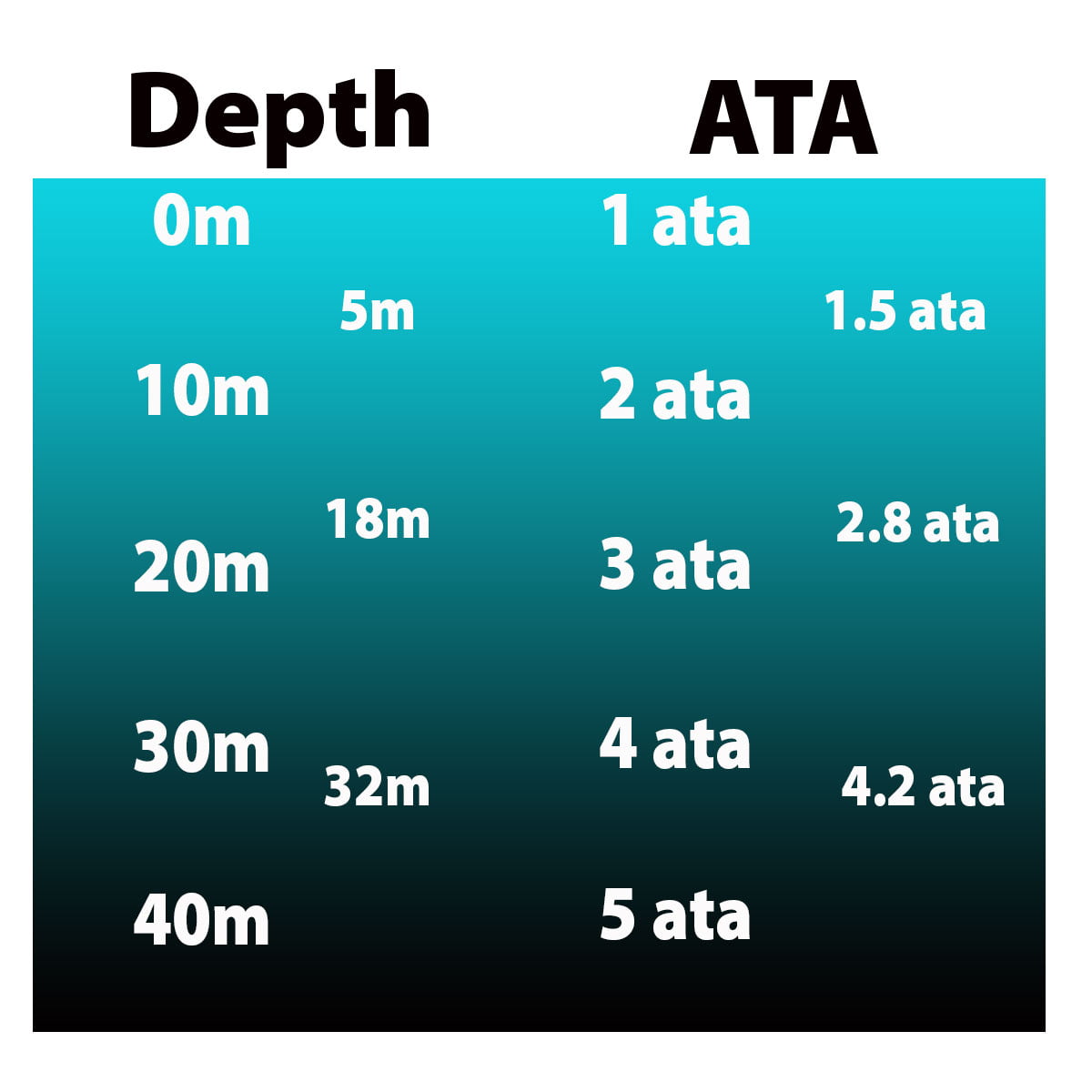
Depth to ATA calculation
Converting depth in meters to atmospheres (absolute) is a very easy process. With a very small amount of practice, you’ll automatically just intuit the conversion without having to make mental calculations.
Metric depth to ATA formula
(Depth in meters ÷ 10) + 1
Example of metric depth to ATA calculation:
24m ÷ 10 = 2.4
2.4 + 1 = 3.4 ata
Imperial depth to ATA formula
(Depth in feet ÷ 33) + 1
Example of imperial depth to ATA calculation:
80ft ÷ 33 = 2.4
2.4 + 1 = 3.4 ata
The math calculation using imperial gets even more complex as we go further through the gas planning steps. For simplicity, I will use the metric system only in further calculations.
Surface Air Consumption Calculation
The next step in the gas planning process is to calculate your Surface Air Consumption (SAC). There are a variety of practical methods used to calculate this figure, but what you’ll end up with is the volume of air (liters or cu ft) breathed per minute at the surface pressure of one atmosphere (1 ata).
In order to calculate your SAC, you will need to know your gas consumption for a given time, at a given depth. Simply spend 10 minutes undertaking normal activity at a set depth and monitor your SPG to see how many BAR of gas you have consumed. Once you have that figure, it reflects the pressure of gas you have consumed from your cylinder at depth. There are some simple maths to convert that into a volume of air consumed at 1 ata.
The SAC formula
To calculate your SAC, use the following metric formulae:

Example SAC calculation:
Volume (11.1L) x BAR (100) = Gas Used (1110L)
Gas (1110L) ÷ Time (10 Min) = L/min (111L/min)
L/min (111) ÷ 3 ATA (20m) = SAC (37L/min)
Accurate SAC rate calculation
A more realistically accurate SAC measurement can be achieved if you have a dive computer that records your average depth for each dive. Simply note your total gas consumption for an entire dive, and then use total dive time and average depth in your formula. This gives an average gas consumption across the whole dive which accounts for normal fluctuations in exertion, stress, and respiratory rate over time.
- Start SPG reading: 200 bar
- End SPG reading:80 bar
- Total dive time: 40 minutes
- Average depth: 16 meters (2.6 ata)
- AL100 cylinder: 13.2 liters volume
Start SPG (200) – End SPG (80) = 120 bar gas consumption
Tank Volume (13.2L) x BAR used (120) = 1584L gas used
Gas used (1584L) ÷ Time (40Mins) = 39.6 L/min
L/min (39.6) ÷ 2.6 ATA (16m) = SAC (15.2L/min)
If you invest a couple of minutes calculating your SAC rate at the end of every dive, you will be able to track how it changes over time and how specific conditions and events affect it. Some dive training agencies, such as RAID, make this a performance requirement on every course from Open Water Diver onwards.
Calculating Gas Consumption at Depth
Respiratory Minute Volume
That depth-adjusted gas consumption figure is referred to as the Respiratory Minute Volume (RMV).
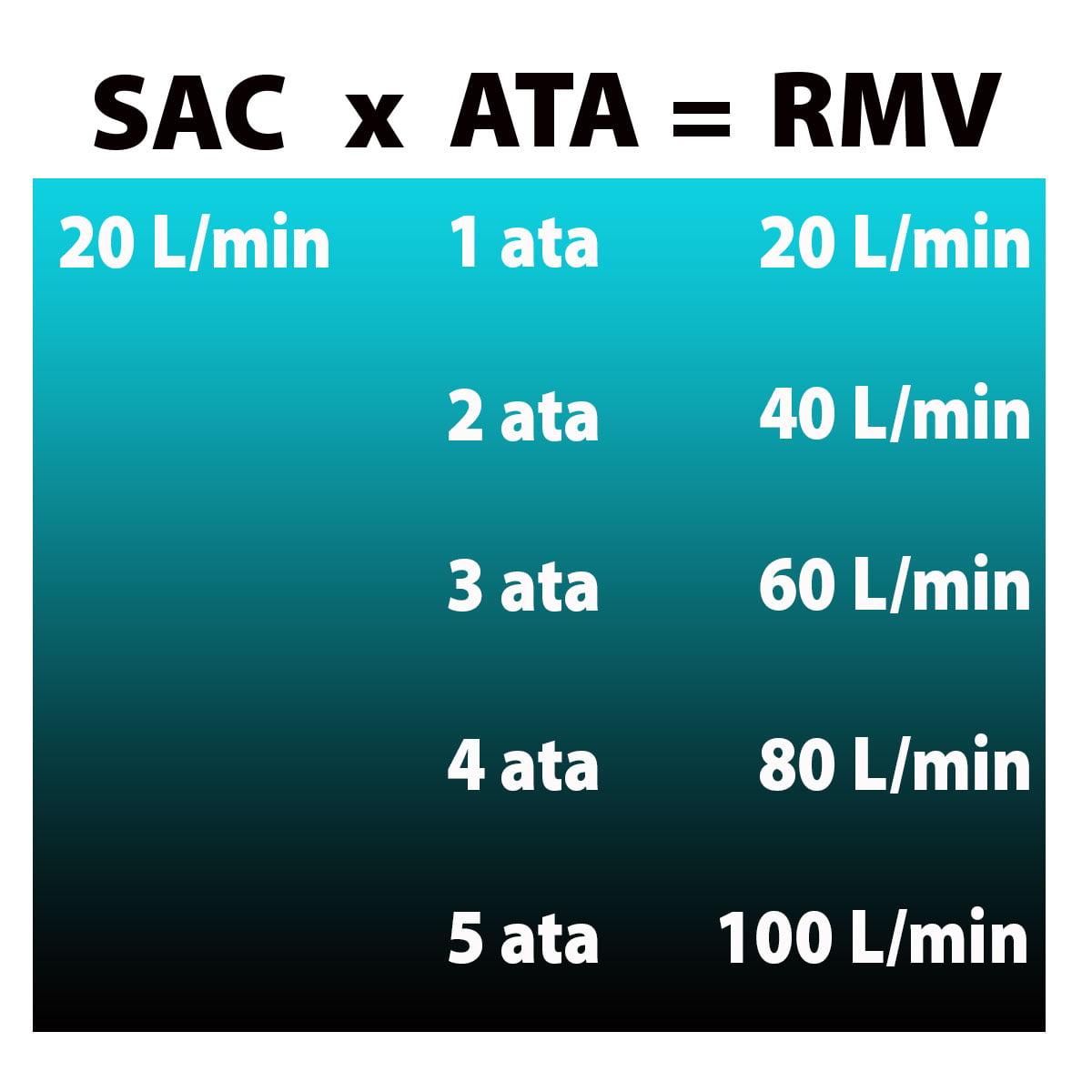
The RMV calculation
To calculate your RMV, use the following metric formulae:
SAC x Depth = RMV
Example RMV calculation
- SAC = 20L/min
- Depth = 20m (3 ata)
SAC (20 L/min) x Depth (3 atm) = RMV (L/min)
A diver who calculated their SAC as 20Lpm would consume 60L/min at a depth of 20m. Their RMV@3ata would be 60L/min.
Once you know your gas consumption at a planned depth, you can easily calculate how long that gas will last you. This is known as the gas duration.
Calculating Gas Duration at Depth
As you already know the gas volume of your cylinder and your gas consumption rate at depth, it is easy to calculate how much time your gas will last at a planned depth.
Calculating usable versus reserve gas
Obviously, responsible scuba divers do not plan to consume all of their gas on a dive. It is a common safe diving practice to reserve a proportion of one’s gas for unforeseen contingencies and emergencies.
Allocating the available gas volume between usable gas and reserve gas is simply a case of deciding upon the fraction of gas you wish to withhold as insurance for worst-case scenarios.
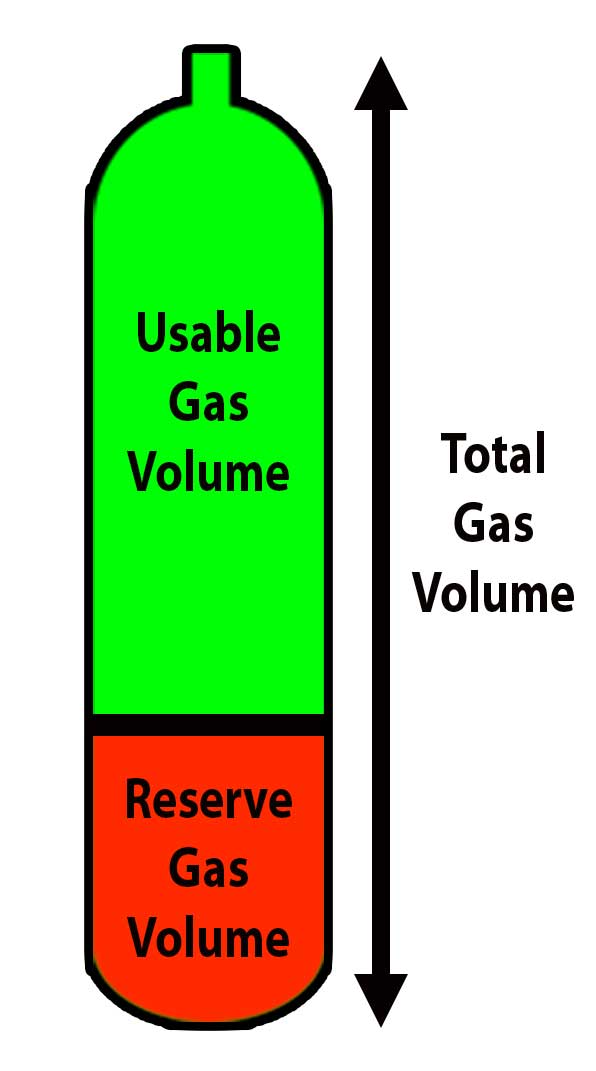
Common reserve gas pressures in scuba diving
- 1/6 Gas Reserve: This is a common Imperial reserve pressure where 500psi is reserved from a 3000psi cylinder fill.
- 1/4 Gas Reserve: This is a common Metric reserve pressure where 50 bar is reserved from a 200 bar cylinder fill.
- 1/3 Gas Reserve: This is a common reserve pressure in technical, cave, and wreck penetration diving; known as the “rule of thirds“.
Calculating reserve and usable gas volume
Simply divide the total gas volume in your cylinder by the fraction you wish to retail as a reserve.
Gas volume ÷ Reserve Fraction = Reserve Volume
For example:
To calculate a 1/4 reserve gas volume using an AL80 filled to 200 bar contains 2200 liters of gas.
Gas volume (2200L) ÷ Reserve Fraction (1/4)
= Reserve Volume (550L)
To calculate the usable gas volume, simply subtract the reserve volume from the total volume.
Gas Volume – Reserve Volume = Usable Volume
For example:
Gas Volume (2200L) – Reserve Volume (550L)
= Usable Volume (1650L)
Calculating BAR/min for dive management
Dealing with gas volume is ideal for pre-dive planning, but when actually on the dive, it can be helpful to understand your gas consumption in relation to the readings on your submersible pressure gauge (SPG).
To convert from L/min to BAR/min, simply divide your RMV by the cylinder volume:
RMV ÷ Cylinder Volume = BAR/min
As an example, if diving with an AL80 cylinder:
RMV (25L/min) ÷ Cylinder Volume (11.1L)
= 2.25 Bar/min
Calculating the gas duration on a dive
Once you know how much gas is available for your dive whilst retaining a reserve, it is an easy process to divide that usable volume by your RMV at a planned diving depth.
Using the figures from previous examples:
Usable Volume (1650L) ÷ RMV (60L/min)
= Gas Duration (27.5 minutes)
In that example, a diver with a SAC of 20L/min using a 200bar AL80 cylinder, with 50bar reserve, would have 27.5 minutes of gas duration at 20m (3ata).
Once you’ve done enough diving to know your reliable SAC rate, you can produce a convenient gas planning table of your air consumption at a range of depths. Print that out, laminate it, and store it in your BCD pocket.
Gas Planning Table
Here is an example Gas Planning Table for a diver with a SAC of 20L/min who dives with an AL80 cylinder and 50bar reserve (150bar/1650L of usable gas):
DEPTH | RMV | SPG | Duration |
5m | 30L/min | 2.7 bar/min | 55 min |
10m | 40 L/min | 3.6 bar/min | 41 min |
15m | 50L/min | 4.5 bar/min | 33 min |
20m | 60L/min | 5.4 bar/min | 27 min |
25m | 70L/min | 6.3 bar/min | 23 min |
30m | 80L/min | 7.2 bar/min | 20 min |
35m | 90L/min | 8.1 bar/min | 18 min |
40m | 100L/min | 9 bar/min | 16 min |
- please note, the table may not display the columns and rows correctly on mobile devices with smaller screens. It is best viewed on a desktop or tablet to see how it’d be printed out.
You could make that table more comprehensive by adding a column for your accelerated (stressed/exerted) SAC rate. This would be helpful in emergency management if you had the table with you underwater.
You could also include more columns for different-sized cylinders that you might use; such as AL100, or if you used a pony cylinder, i.e. AL30 or AL40.
Calculating ascent gas consumption
If you aim to return from your dive without having violated your gas reserve, it is important to calculate how much gas you will consume as you ascend to the surface.
Calculating the average ascent depth
To do this, we can use the steps that we already know, and just calculate utilizing an average ascent depth; the mid-depth between the surface and the bottom depth.
For example, if the diver was at 20m, the average depth for their ascent would be 10m.
As the diver should be ascending at an optimal rate of 10m/min, that ascent should take two minutes.
Ascent Depth ÷ Ascent Rate = Ascent Time
20m ÷ 10m/min = 2 mins
In this case, we can calculate gas consumption based on 2 mins at the average depth of 10m.
SAC (20L/min) x ATA (2ata) = RMV (40L/min)
RMV (40L/min) x Ascent Time (2min) = Gas (80L)
To make that information relevant to your dive management, simply convert from volume to SPG reading:
Ascent Gas (80L) ÷ Cylinder Volume (11.1L) = Bar Used (7.2)
The diver would require 7.2 bar to make their ascent from 20m directly to the surface. If they leave the bottom when they reach 58 bar on their SPG, they will surface with a 50 bar reserve intact.
Calculating average ascent depth with a safety stop
In most circumstances, scuba divers conduct recommended safety stops. If you want to calculate ascent gas consumption including a safety stop, you will need to break the calculation into two parts: the ascent and the safety stop.
Based on the example already used, the diver needs 7.2 bar for the actual ascent. We now only need to work out their consumption on the safety stop.
Assuming a 3-minute stop at 5m (1.5ata), this would be:
SAC (20L/min) x Depth (1.5ata) = RMV (30L/min)
RMV (30L/min) x Time (3 mins) = Gas Used (90L)
Gas (90L) ÷ Cylinder Volume (11.1) = Bar Used (8.1)
The diver would require 7.2 bar for the ascent and 8.1 bar for their safety stop; a total of 15.3 bar. If they left the bottom with 66 bar, they would surface with their 50-bar reserve intact.
Calculating a realistic gas reserve volume
Using an arbitrary gas reserve pressure based on simple fractions does not account for a number of critical factors. You cannot be sure if you have an adequate reserve unless you have factored in variables like the depth, your own SAC rate, and the potential need to donate gas to a buddy.
As we’ve already learned how to calculate gas consumption for a normal ascent, it is easy to use the same process to calculate how much gas would actually be necessary for the worst-case scenario: an air-sharing ascent. Calculating an accurate gas reserve is known as Rock Bottom Gas Reserve.
What is a Rock Bottom Gas Reserve?
A Rock Bottom Gas Reserve is defined as the minimum amount of gas for 2 divers to ascend safely whilst sharing gas.
Calculating a Rock Bottom Gas Reserve ensures that the diver has enough gas to rescue an out-of-air buddy with a safe ascent rate and safety stop that doesn’t risk decompression sickness (DCS).
Calculating Rock Bottom Gas Reserves
In order to calculate the Rock Bottom Gas Reserve, you calculate gas consumption in three stages using the process already described:
- 1 minute at bottom depth for stress management
- Average ascent depth x ascent time
- Safety stop (3 mins at 5m/1.5ata)
As you are planning for the contingency of an air-sharing ascent, you also have to account for your buddy’s gas consumption. If they are aware of their SAC rate, you can calculate that accurately during pre-dive planning. If they don’t know their SAC rate, you can simply double your own gas consumption figures.
Example Rock Bottom Gas Reserve calculation
In this instance, I will demonstrate calculating a Rock Bottom Gas Reserve for a dive at 40m/130ft.
1: Calculate for 1 min at the bottom
- SAC (20L/min) x Depth (5ata) = RMV (100L/min)
- RMV (100L/min) x Time (1 mins) = Gas Used (100L)
- Double gas volume for air-sharing = Gas Used (200L)
- Gas (200L) ÷ Cylinder Volume (11.1) = 18 Bar
2: Calculate the ascent
- Average Depth: 40m ÷ 2 = 20m (3ata)
- SAC (20L/min) x Depth (3ata) = RMV (60L/min)
- Ascent Time: 40m ÷ 1m/min = 4 mins
- RMV (60L/min) x Time (4 mins) = Gas Used (240L)
- Double gas volume for air-sharing = Gas Used (480L)
- Gas (480L) ÷ Cylinder Volume (11.1) = 43 Bar
3: Calculate the safety stop
- SAC (20L/min) x Depth (1.5ata) = RMV (30L/min)
- RMV (30L/min) x Time (3 mins) = Gas Used (90L)
- Double gas volume for air-sharing = Gas Used (180L)
- Gas (180L) ÷ Cylinder Volume (11.1) = 17 Bar
4: Calculate the total gas reserve
- 18 Bar + 43 Bar + 17 Bar = 78 Bar minimum reserve
In this example, the diver should leave the bottom when they reach 78 bar on their SPG. Any less and they would be unable to conduct a safe ascent if they were required to donate gas!
Assume accelerated gas consumption in emergencies
In a real-life out-of-air emergency it is unlikely that either the gas donor or receiver will retain a normal respiratory rate. It is prudent to consider adding further conservatism to the Rock Bottom Gas Reserve by more than doubling the combined gas consumption. This obviously has to be balanced against the practical amount of gas you want to use when enjoying your dives.
If you wanted to add more conservatism to the emergency gas reserve and account for stressed breathing, you could triple, rather than double, the combined gas consumption. Using the example before, this would work out as a 117 Bar minimum reserve!
Hopefully, that figure should inspire respect and caution about the reality of air-sharing emergency ascents on deep recreational dives. This is why experienced divers will routinely equip themselves with a redundant gas cylinder for deep dives; a pony, backmount double cylinders, or sidemount configuration.
Creating a Rock Bottom Gas Reserve Table
If you are prepared to crunch some mathematics you can add a Rock Bottom Reserve column to the Gas Planning Table that I described earlier. This will be an immediate reference that indicates the minimum reserve for any depth level during your dives.
It can be especially useful when multi-level diving; as you can progress from one Rock Bottom Reserve to the next as you ascend to shallower depths.
Example Rock Bottom Reserve Table
This table was produced using the same factors as the previous examples; a diver with SAC 20L/min using an AL80 (11.1L) filled to 200 bar.
In this case, gas-sharing volumes are simple doubles, assuming a buddy with the same, or less, SAC rate and that neither diver suffers an increased respiratory rate due to stress. I have included a column for +50% consumption which reflects having a buddy with a higher SAC rate, or elevated gas consumption due to emergency stress.
DEPTH | Rock Bottom | +50% |
5m | ||
10m | 31 Bar | 47 Bar |
15m | 36 Bar | 54 Bar |
20m | 43 Bar | 65 Bar |
25m | 50 Bar | 75 Bar |
30m | 59 Bar | 89 Bar |
35m | 70 Bar | 105 Bar |
40m | 78 Bar | 117 Bar |
- please note, the table may not display the columns and rows correctly on mobile devices with smaller screens. It is best viewed on a desktop or tablet to see how it’d be printed out.
Conclusion: Gas Planning For Scuba Divers
In conclusion, scuba gas planning and diving gas management are essential skills that every diver should master to enhance their underwater experience.
This article has provided a comprehensive guide to help you understand the techniques and principles of scuba gas planning and diving gas management.
I’ve covered everything from calculating gas consumption rates to ensuring that emergency gas reserves are appropriate for your dives.
Start implementing this diving knowledge today and see how much it enhances your safety and confidence as gas planning becomes second nature for your scuba dives!

This article is now available as an illustrated, printable PDF ebook for download.
About The Author

Andy Davis is a RAID, PADI TecRec, ANDI, BSAC, and SSI-qualified independent technical diving instructor who specializes in teaching sidemount, trimix, and advanced wreck diving courses.
Currently residing in Subic Bay, Philippines; he has amassed more than 10,000 open-circuit and CCR dives over three decades of challenging diving across the globe.
Andy has published numerous diving magazine articles and designed advanced certification courses for several dive training agencies, He regularly tests and reviews new dive gear for scuba equipment manufacturers. Andy is currently writing a series of advanced diving books and creating a range of tech diving clothing and accessories.
Prior to becoming a professional technical diving educator in 2006, Andy was a commissioned officer in the Royal Air Force and has served in Iraq, Afghanistan, Belize, and Cyprus.
In 2023, Andy was named in the “Who’s Who of Sidemount” list by GUE InDepth Magazine.
Purchase my exclusive diving ebooks!
Originally posted 2023-03-13 18:59:48.







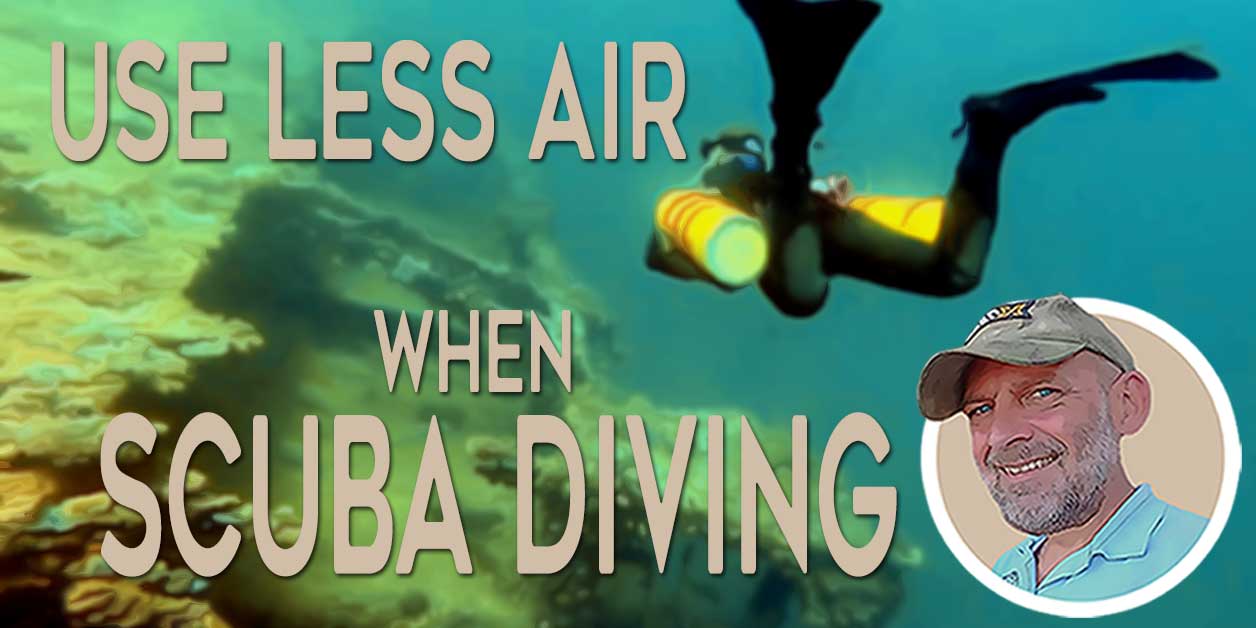





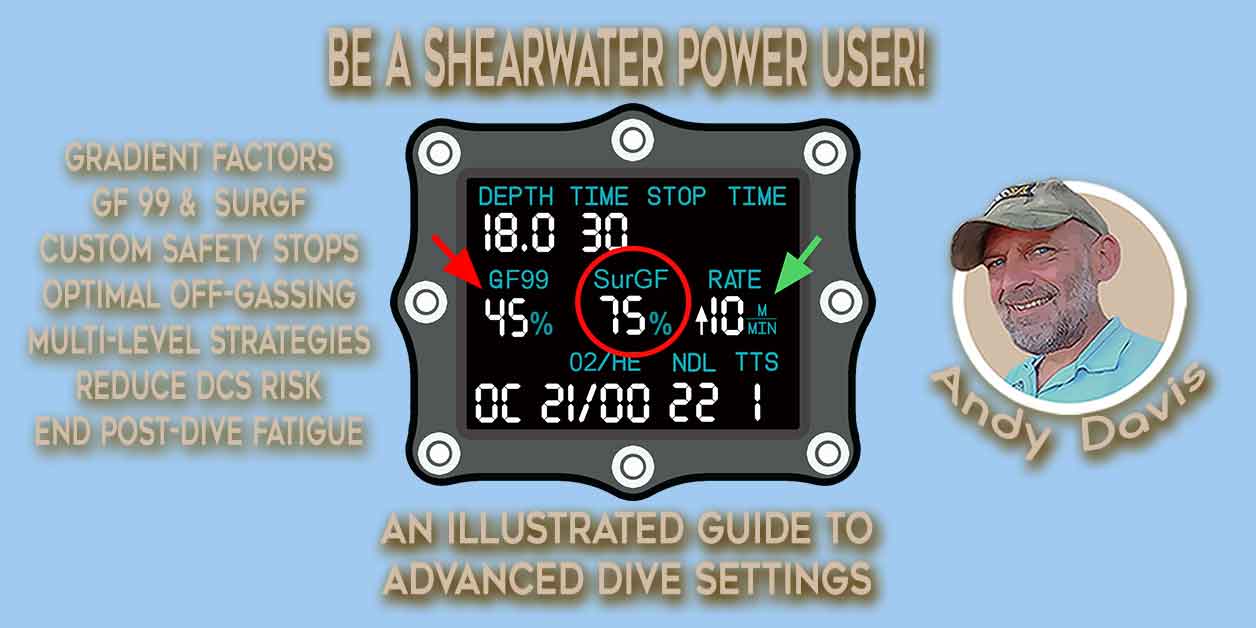

Very useful as I’m looking to expand my knowledge and become a safe diver. Well written, easy to follow and implement. I’ll start taking note of my SAC rate and create a table to refer to. Thanks!
Well written and easy to read and absorb. I must say, how often do any of us include in our calculations a “real” emergency air share into our gas reserve calcuiation?
Excellent advice as usual Andy. Thanks for sharing your knowledge and experience. Hoping to get over to the Phillipines to do some advanced training with you.
All the best,
Alex
Great info , thank you
Hi Andy,
Great Info! I learned to dive using the imperial system and have been looking for a solid write up on diving metric. I am moving to Cyprus from Canada, next year and want to be accustomed to metric before I go.
I bought you a few coffees! Thanks for making your experience and knowledge readily available.
Cheers.
Pete